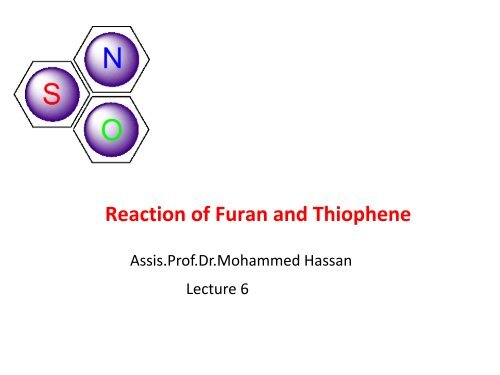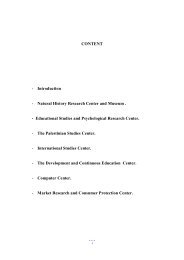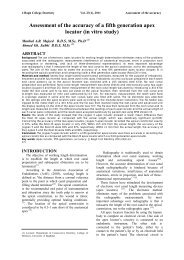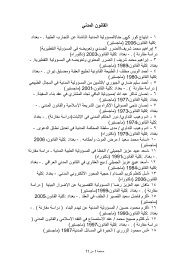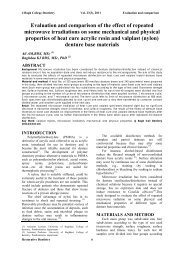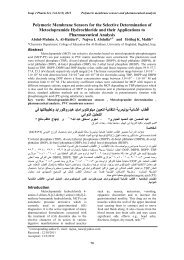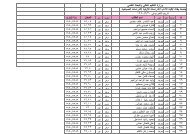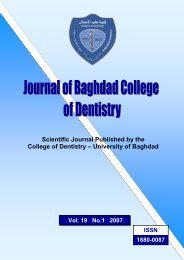Reaction of Furan and Thiophene
Reaction of Furan and Thiophene
Reaction of Furan and Thiophene
Create successful ePaper yourself
Turn your PDF publications into a flip-book with our unique Google optimized e-Paper software.
<strong>Reaction</strong> <strong>of</strong> <strong>Furan</strong> <strong>and</strong> <strong>Thiophene</strong><br />
Assis.Pr<strong>of</strong>.Dr.Mohammed Hassan<br />
Lecture 6
a) Oxidation<br />
Br 2 / CH 3 OH<br />
H<br />
O<br />
MeO<br />
H<br />
O OMe<br />
cis / trans<br />
2,5-Dihydro-2,5-dimethoxyfuran<br />
This reaction involves electrophilic addition <strong>of</strong> bromine in<br />
presence <strong>of</strong> methanol at 2 & 5 positions followed by<br />
substitution by methanol.<br />
<strong>Thiophene</strong> is oxidized by peracids to <strong>Thiophene</strong>-1-oxide <strong>and</strong><br />
2-hydroxythiophene oxide.<br />
S<br />
O<br />
S<br />
O<br />
OH
Raney Ni / H 2<br />
b) Reduction<br />
O<br />
O<br />
2-Methyltetrahydr<strong>of</strong>uran<br />
On the other h<strong>and</strong> thiophene can not be reduced under the<br />
same conditions due to sulfur poison the catalyst <strong>and</strong><br />
desulphurization occurs with ring opening.<br />
However, partial reduction can take place by metals in<br />
acidic medium.<br />
Raney Ni / H 2<br />
+ NiS<br />
S<br />
Zn / HCl<br />
S CH 2 CH 3 S<br />
CH 2 CH 3
Electrophilic Aromatic substitution <strong>Reaction</strong>s<br />
1) Nitration<br />
O<br />
CH 3 COONO 2<br />
Pyridine<br />
O<br />
NO 2<br />
S<br />
CH 3 COONO 2<br />
AcOH / Ac 2 O<br />
2) Sulphonation<br />
S<br />
NO 2<br />
O<br />
N<br />
SO 3<br />
SO 3 / Pyridine complex<br />
HO 3 S<br />
O<br />
SO 3 H<br />
S<br />
95 % H 2 SO 4<br />
S<br />
SO 3 H<br />
Heterocyclic Chemistry
3) Halogenation<br />
NBS<br />
S<br />
S<br />
Br<br />
X<br />
X<br />
O<br />
X 2 / r.t<br />
x= Clor Br<br />
X<br />
O<br />
X<br />
Cl 2 / CH 2 Cl 2<br />
- 40 C°<br />
Br 2 / Dioxane<br />
O<br />
Cl<br />
0 C ° O Br<br />
Indirect insertion <strong>of</strong> iodine in furan ring<br />
I 2 / KI<br />
O<br />
COOH<br />
KOH<br />
O I<br />
Heterocyclic Chemistry
4) Acylation<br />
(CH 3 CO) 2 O /<br />
S<br />
S<br />
COCH 3<br />
H 3 PO 4<br />
(CH 3 ) 2 CCl / FeCl 3<br />
Ac 2 O / SnCl 4<br />
O<br />
O<br />
COCH 3<br />
5) Alkylation<br />
It is very low yielding reaction due to formation <strong>of</strong><br />
polyalkylated products or polymers.<br />
O<br />
Heterocyclic Chemistry<br />
t-Bu<br />
O<br />
t-Bu
4) Lithiation<br />
X<br />
X = O, S<br />
BuLi<br />
X<br />
Li<br />
RX<br />
X<br />
R<br />
5) Diazocoupling:<br />
<strong>Furan</strong> <strong>and</strong> thiophene can not couple with diazonium salts<br />
which shows that they are less reactive than pyrrole.<br />
O<br />
Ar N=N + Cl -<br />
No <strong>Reaction</strong><br />
S<br />
Heterocyclic Chemistry
Second Electrophilic Substitution in <strong>Furan</strong> <strong>and</strong><br />
<strong>Thiophene</strong><br />
a) Monosubstituted furan & thiophene with electron withdrawing groups such as<br />
COOH, CHO, CN, COR, SO 3 H are less reactive than unsubstitutted compounds<br />
i) EWG at position 2<br />
O 2 N<br />
HNO 3 (incoming E + is directed to m-position i.e. position 4)<br />
S CN S CN<br />
Less reactive than thiopene<br />
O 2 N<br />
+<br />
CH COONO 3 2<br />
O CHO<br />
O 2 N O CHO O CHO<br />
Pyridine<br />
Less reactive than furan<br />
O<br />
COOH<br />
Br 2 / Dioxane<br />
ii) EWG at position 3<br />
3 : 1<br />
(incoming E + is directed to position 5 mainly <strong>and</strong> to position 4<br />
as well )<br />
Br<br />
+<br />
Br O COOH<br />
O COOH<br />
X<br />
EWG<br />
E +<br />
E<br />
X<br />
EWG<br />
(incoming E + is directed to position 5)<br />
Heterocyclic Chemistry
) Monosubstituted furan & thiophene with electron donating group such as CH 3 , OH, NH 2 ,<br />
OCH 3<br />
i) EDG at position 2<br />
E + O COCH 3<br />
X<br />
EDG<br />
More reactive than unsubstituted<br />
compound<br />
E<br />
X<br />
EDG<br />
(incoming E + is directed to position 5)<br />
ii) EDG at position 3<br />
EDG<br />
X<br />
EDG<br />
EDG<br />
or<br />
E + X E<br />
E X<br />
(incoming E + directed to 2 mainly or 5 due to steric effects )<br />
CH 3 CH 3<br />
Ac 2 O / r.t.<br />
+<br />
CH 3<br />
O<br />
25 % H 3 PO 4<br />
H 3 COC<br />
O<br />
Heterocyclic Chemistry
Ac 2 O / HNO 3<br />
H 3 C<br />
S<br />
COOH<br />
H 3 C<br />
S NO 2<br />
(Replacement <strong>of</strong> leaving group takes place)<br />
Heterocyclic Chemistry


